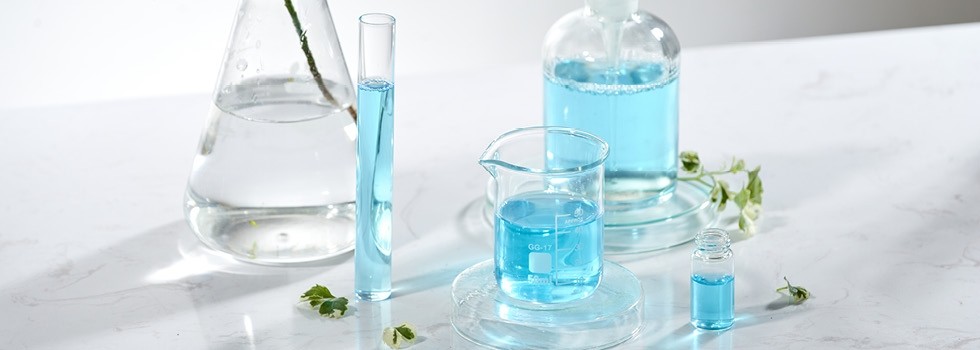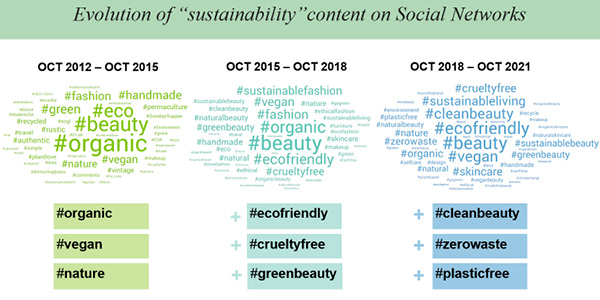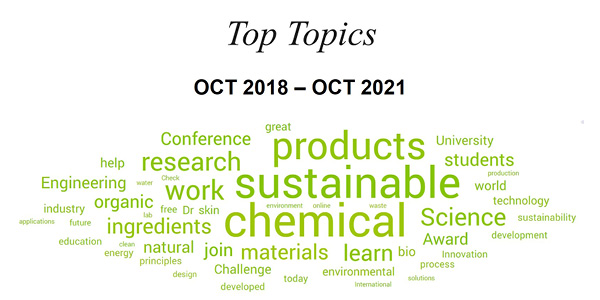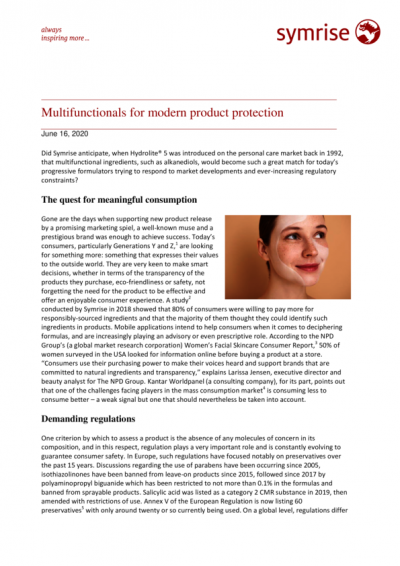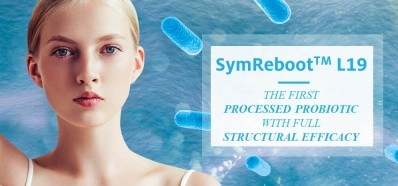Promotional Features
Deep dive into sustainability and cosmetic raw materials
Sustainability plays a key role in today's beauty industry. Symrise’s Consumer & Market Insights department is closely following this topic and its evolution over time. Thanks to Infegy Atlas, a social listening platform1, we studied the mentions of “sustainability” on social networks during three periods of three years (2012 to 2015, 2015 to 2018 and 2018 to 2021). During the first period, this word was mentioned almost 75 million times (including more than 1 million times in topics related to beauty). These mentions multiplied by four in the following years. Sustainability goes beyond a trend. It has become a key topic in our lives, and will stay for the upcoming years and decades.
At first, sustainability in the beauty world related to organic, vegan and nature. Then, new topics came into consideration, such as eco-friendliness, cruelty-free cosmetics and green beauty. Lately hot topics included clean beauty of course, and also zero waste concept and plastic free cosmetics.
Then again, sustainability covers more than these topics. Other ways exist to develop a sustainable approach. Have you ever heard about green chemistry?
Only a few consumers know about this concept. In fact, the low number of mentions on social media suggests it: less than 6,000 mentions in the beauty area over the past three years. Those educated consumers associate green chemistry with sustainable chemical products, as indicated below. So, does green chemistry relates only to products? In fact, a whole world exists around it. Let’s take a closer look …
What does green chemistry stand for precisely?
Green Chemistry is the utilization of a set of principles that reduces or eliminates the use or generation of hazardous substances in the design, manufacture and application of chemical products.” wrote Paul Anastas and John Warner in their groundbreaking book Green Chemistry: Theory and Practice. in 1998.
They defined twelve principles that aim to design products and processes that minimize the use and generation of hazardous substances. Green chemistry follows the overarching goal of more resource-efficient and inherently safer design of molecules, materials, products and processes. Since then, various industries have recognized these principles recognized and use them for paints and coatings or plastic and of course in the personal care industry.
Long before the twelve principles came up, Symrise belonged to one of the pioneers of green chemistry with the synthesis of vanillin in 1874 from renewable natural pine bark.
The twelve principles form a guiding mantra in all research and development at Symrise. The company applies them when developing ingredients or upgrading processes. Our approach on green chemistry focuses on four major criteria addressing the twelve principles.
Let’s dive into more detailed explanations of these four major criteria: Safe use, environmental protection, resource conservation and reduction of emissions.
Safe use means to manufacture products that are cleaner and safer for the consumers to use and for the employees to produce, meeting all safety and regulatory requirements. Our production sites are audited and certified according to ISO standards like ISO 5001 for quality or ISO 45001 for health and safety at work.
Green chemistry contributes to protecting the environment by minimizing or eliminating the use and generation of hazardous material used in a product. It implies the use of catalytic systems during a process, allowing to reduce the number of steps and consequently limiting the energy consumption. Symrise implements an environmental management system on its production sites that are ISO 14001 certified.
Along with protecting the environment, green chemistry also plays an important role in the resource conservation. Thanks to the use of renewable plant-based byproducts via innovative patented processes, Symrise takes advantage of materials that other industries have “left aside”, like food for instance, and upcycle them in high-value and effective ingredients targeting a zero-waste approach.
Finally, green chemistry delivers the key to tackle the causes of climate change. The optimization of manufacturing processes helps significantly reduce CO2 emissions. We have signed up to externally verified science-based targets to limit our greenhouse gas emissions and have also set ourselves the ambitious goal of operating climate positive from 2030 onwards.
Symrise follows the objective to develop products with a better sustainability profile, higher biodegradability and higher renewability whenever possible. The company continuously improves the processes to ensure maximum efficiency, less waste products and low energy consumption. These progresses conform with our commitment to protecting the environment. The renowned non-profit organization CDP (Carbon Disclosure Project) recognizes our efforts. It makes a yearly assessment of what participating companies do to fight climate change, protect water supplies and conserve forests. Symrise has achieved top grade A ratings in all three categories. Only ten out of the 9,600 companies worldwide that took part achieved this, and we are the only one in Germany. Symrise has been ranked Ecovadis Gold for several years in recognition of the actions taken towards environment, Labor&Human Rights, Ethics and Sustainable Procurement.
To illustrate Symrise’s actions we will focus in this article on 2 Cosmetic ingredients categories: Product Protection and Skin Protection.
Emission reduction:
Improvement in sustainability starts at the roots: the production plant.
For instance, we have built a state-of-the-art plant especially for Hydrolite 5 green. It helps reduce our environmental impact by switching from the synthetic version to the green one.
We have equipped our Bushy Park plant to minimize the CO2 emissions linked to production. Actually, the offset of its steam requirement reduces the plant’s overall steam requirements, which in turn mitigates the generation of CO2 that would have been released into the environment as part of the production of this saved steam.
Moreover, Bushy Park carries a SEDEX (Smeta 4-pillars) certificate: with a full assessment of health and safety, labor standards, environment and business ethics.
Resource conservation:
By producing Hydrolite 5 green using an upcycling product from the sugar cane industry, we have improved the sustainable score of the ingredient, while keeping all the advantages of the traditional molecule.
Hydrolite 7 green too uses plants derivatives: Castor beans need only little to grow.
We are also using side products of the chemical production: SymOcide C (o-Cymen-5-ol) production uses p-thymol, a side product of menthol: Symrise engineers developed this production method to make the most out of it and turned it into a widely used preservative!
SymLite G8 (glyceryl caprylate), a green multifunctional acting as co-emulsifier, enhancing the formulation aesthetics, helping with product protection and much more, comes from RSPO mass balance source.
Finally, nature-identical ingredients form a part of the green chemistry story too.
Our SymSave H uses an ingredient that you can find in a small artic berry. It would be completely unsustainable to try to extract it from them. We have developed an identical ingredient with more sustainable properties than the synthetic variant instead of trying to extract it.
Environmental protection:
We have developed the majority of our portfolio with solvent-free processes. In the case of Crinipan PMC green for instance, we are only using propanediol and caprylic acid to obtain the active ingredient, Propanediol Caprylate, completely free of hazardous side products.
We can offer biodegradability data for our Skin Protection and Product Protection portfolio. We are using nature-based ingredients that come from 100% renewable carbons.
In 2020, Symrise saved globally 68,000 tons of CO2 emissions. Our company places sustainability at the center of its business strategy throughout the entire value chain and aims to become climate-positive starting in 2030. Symrise has positioned itself well to successfully pursue the road ahead, as a look into the company’s climate activities demonstrates.
1Infegy Atlas is a social listening platform analyzing online conversation from 400M sources including websites, forums, social networks like TikTok, in 35 languages
